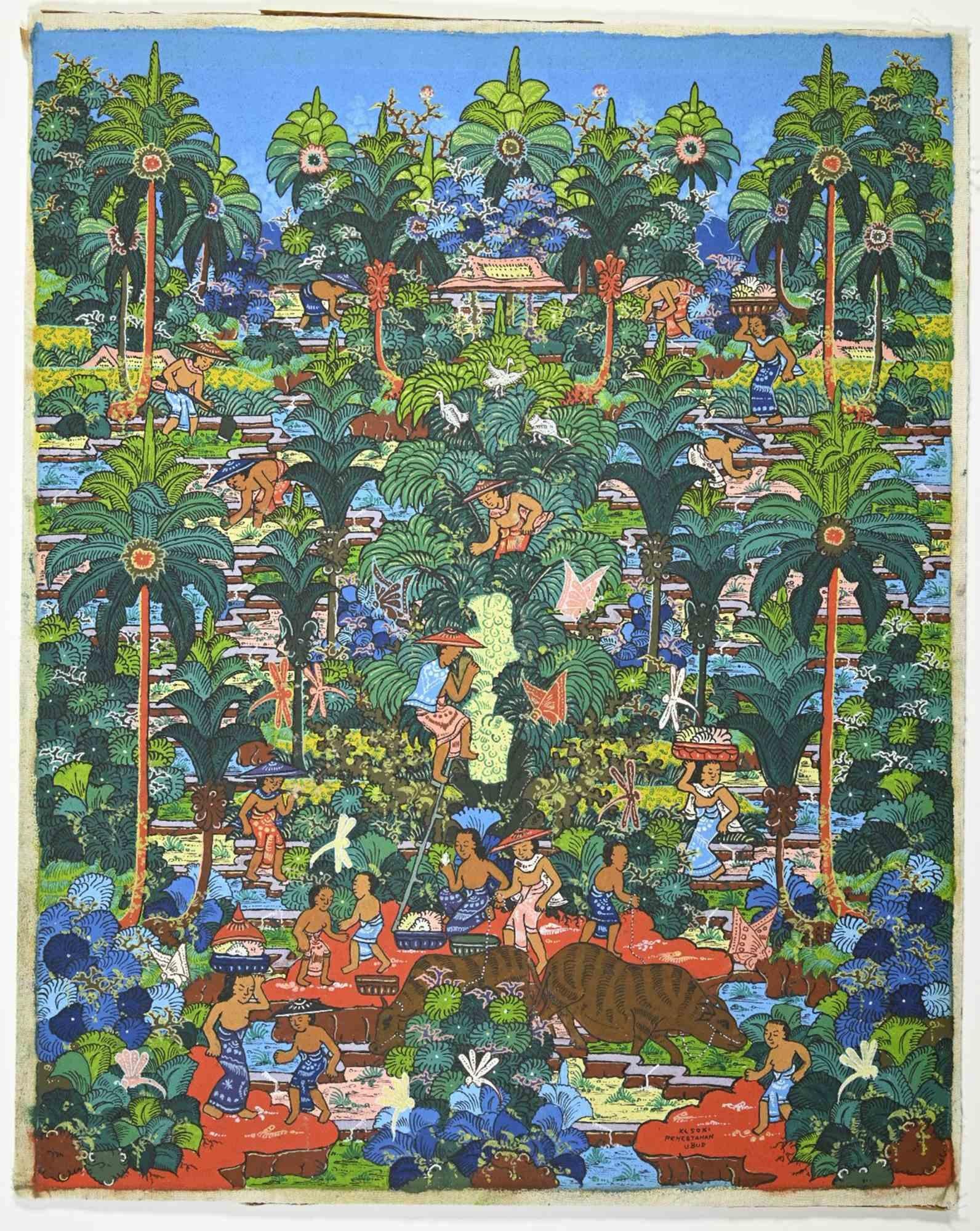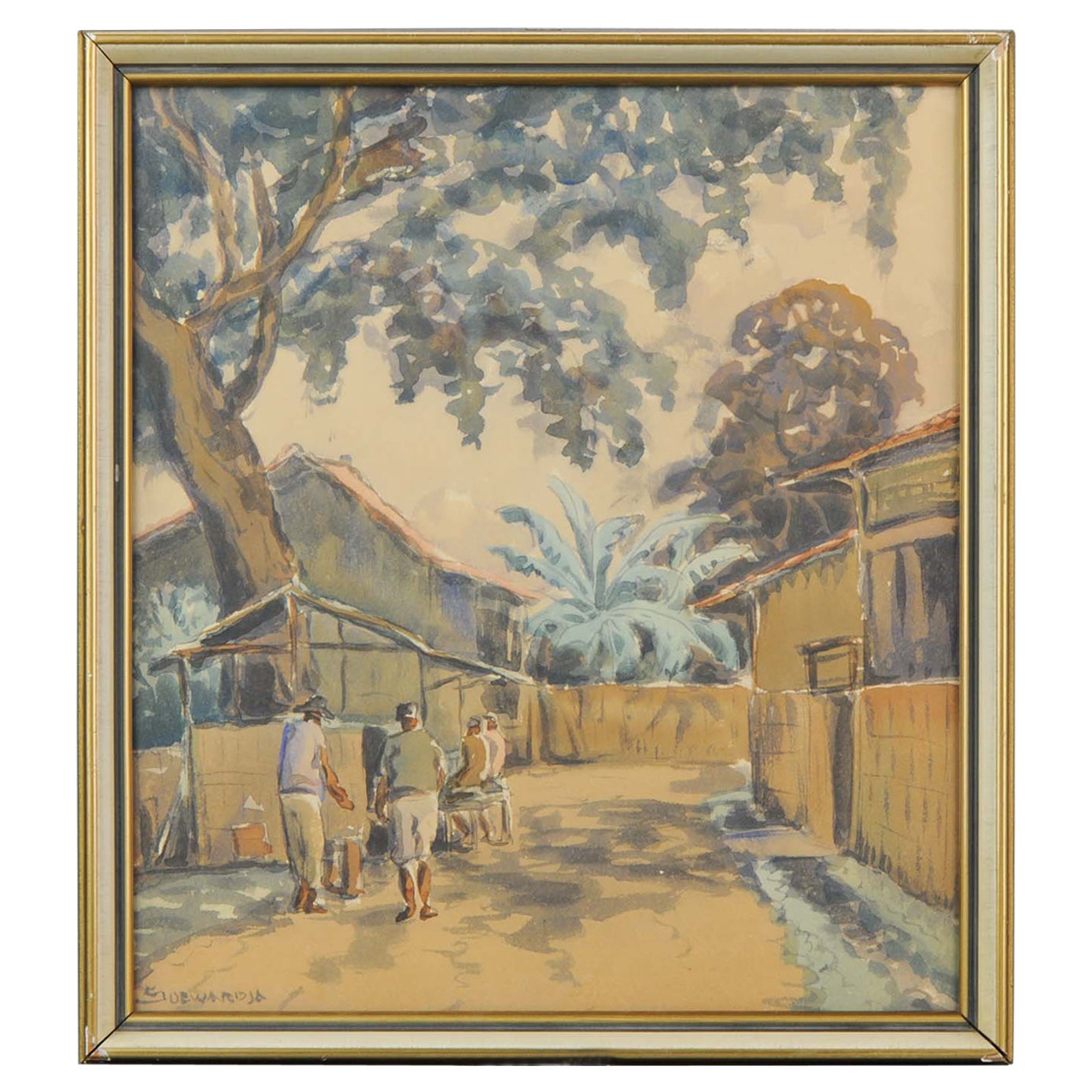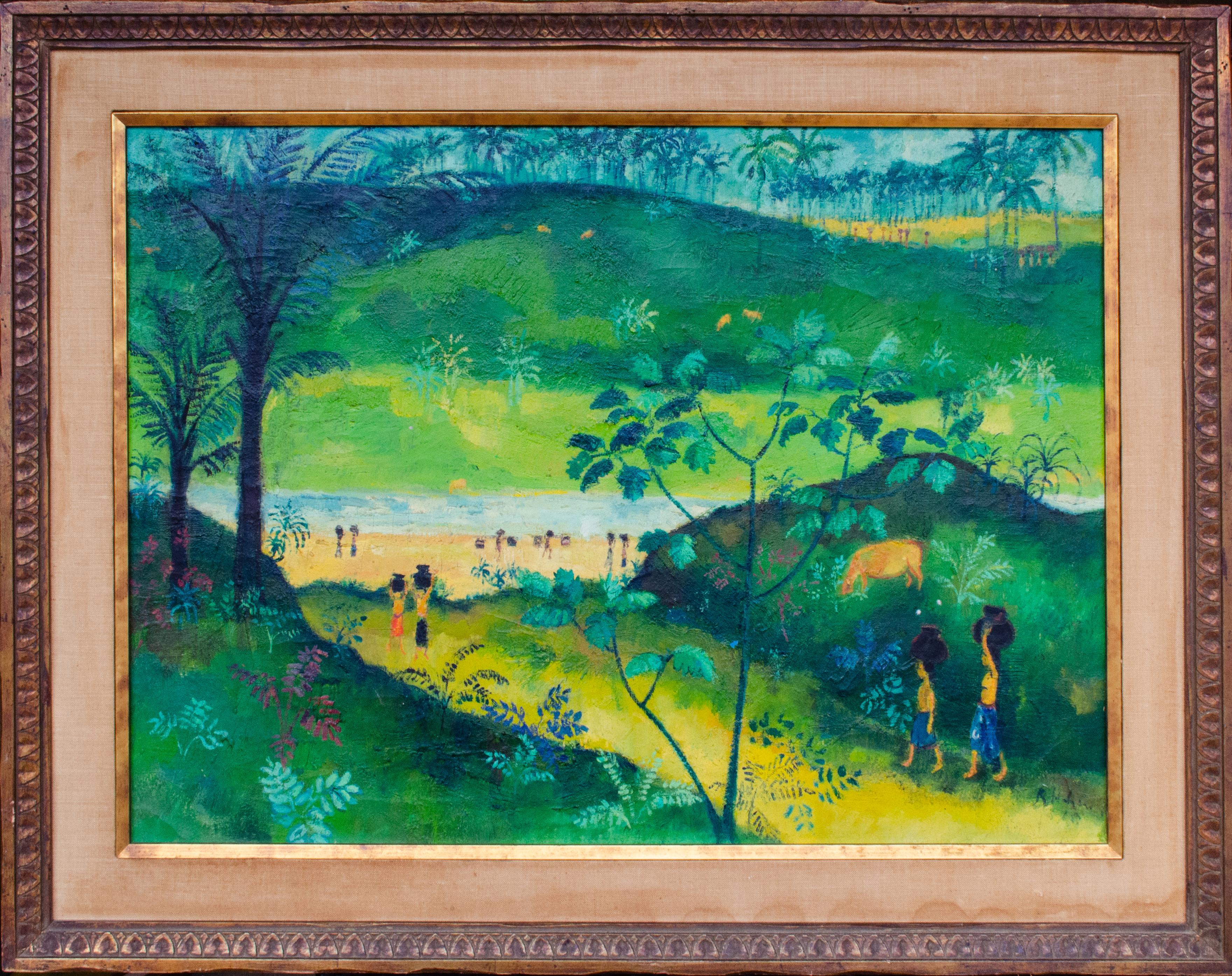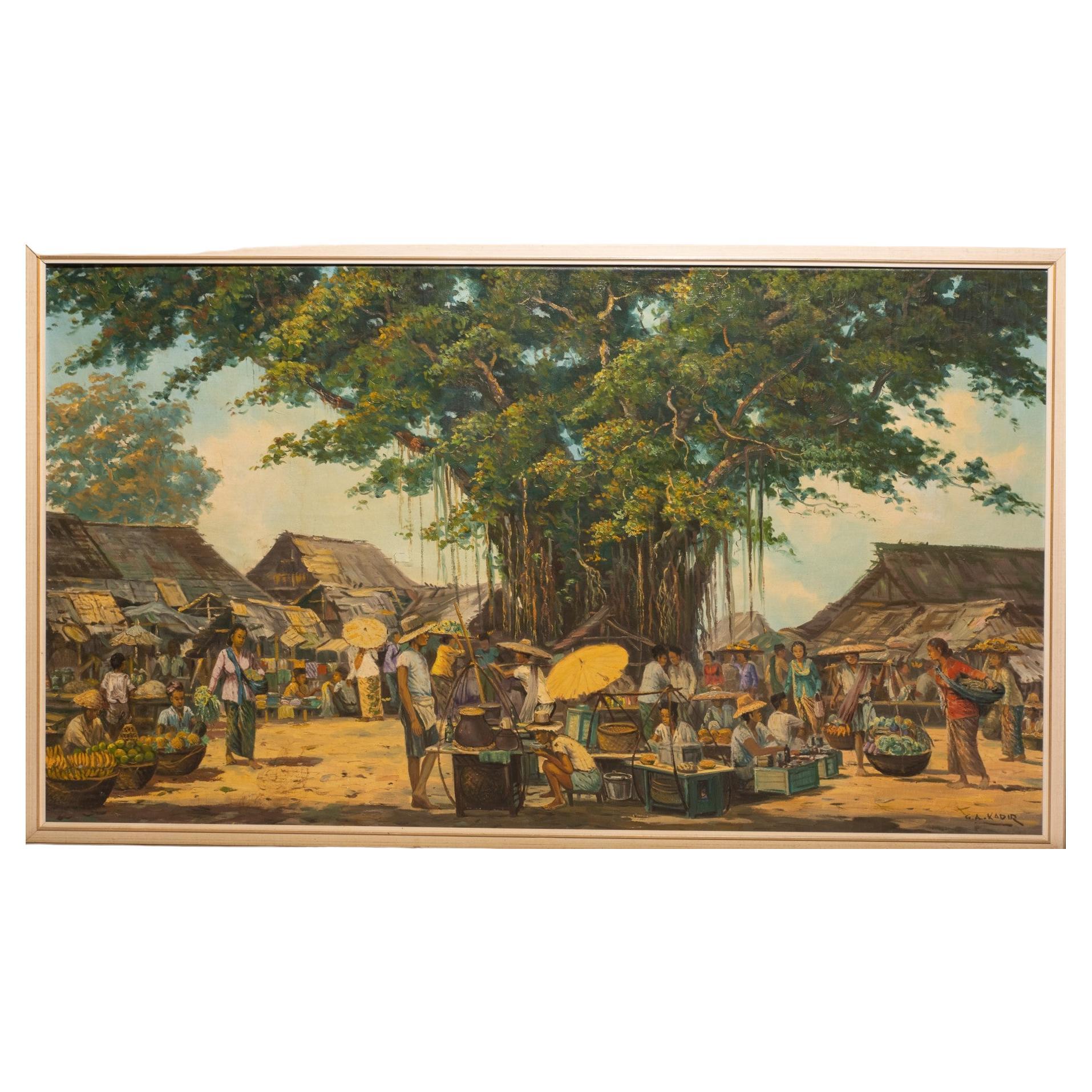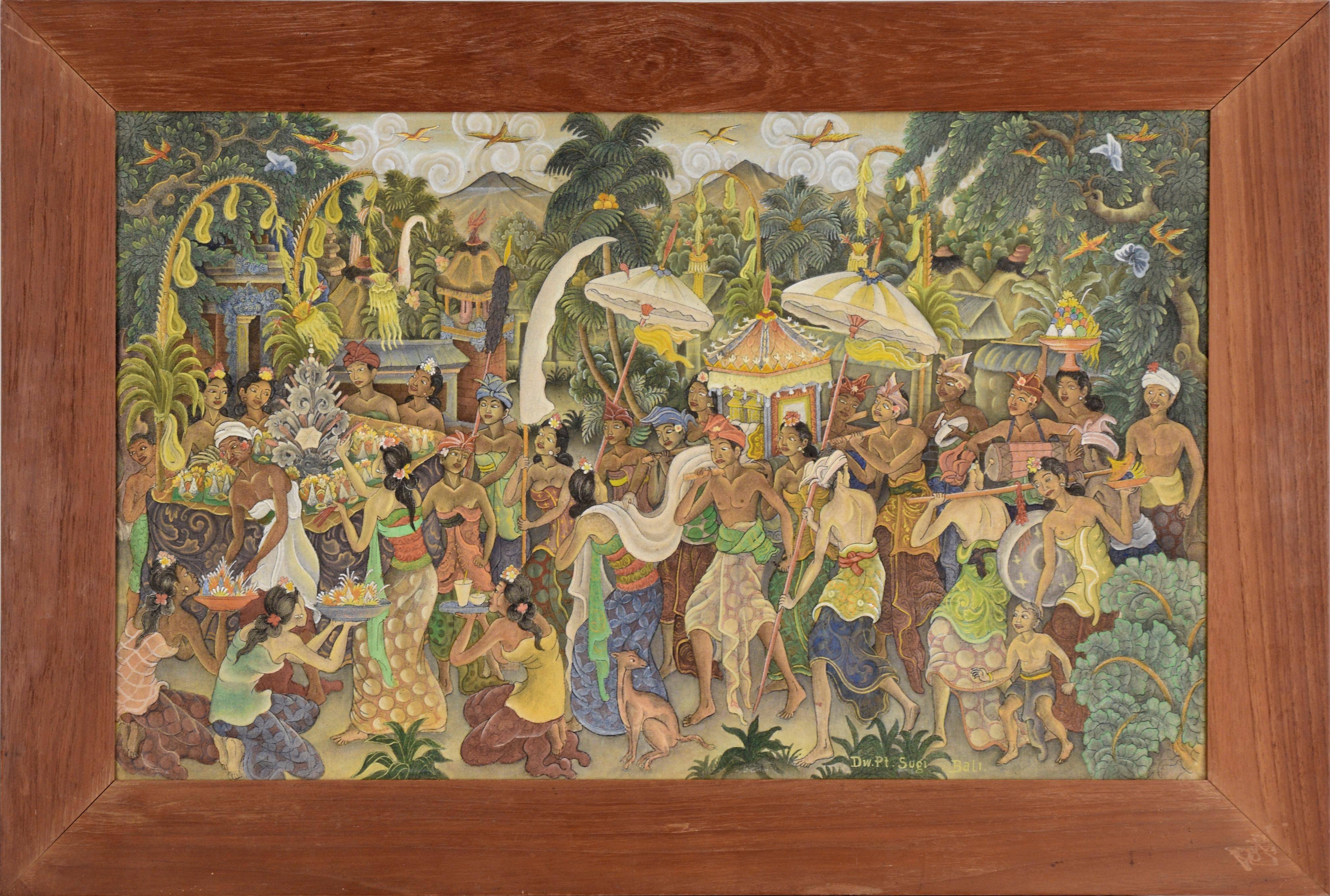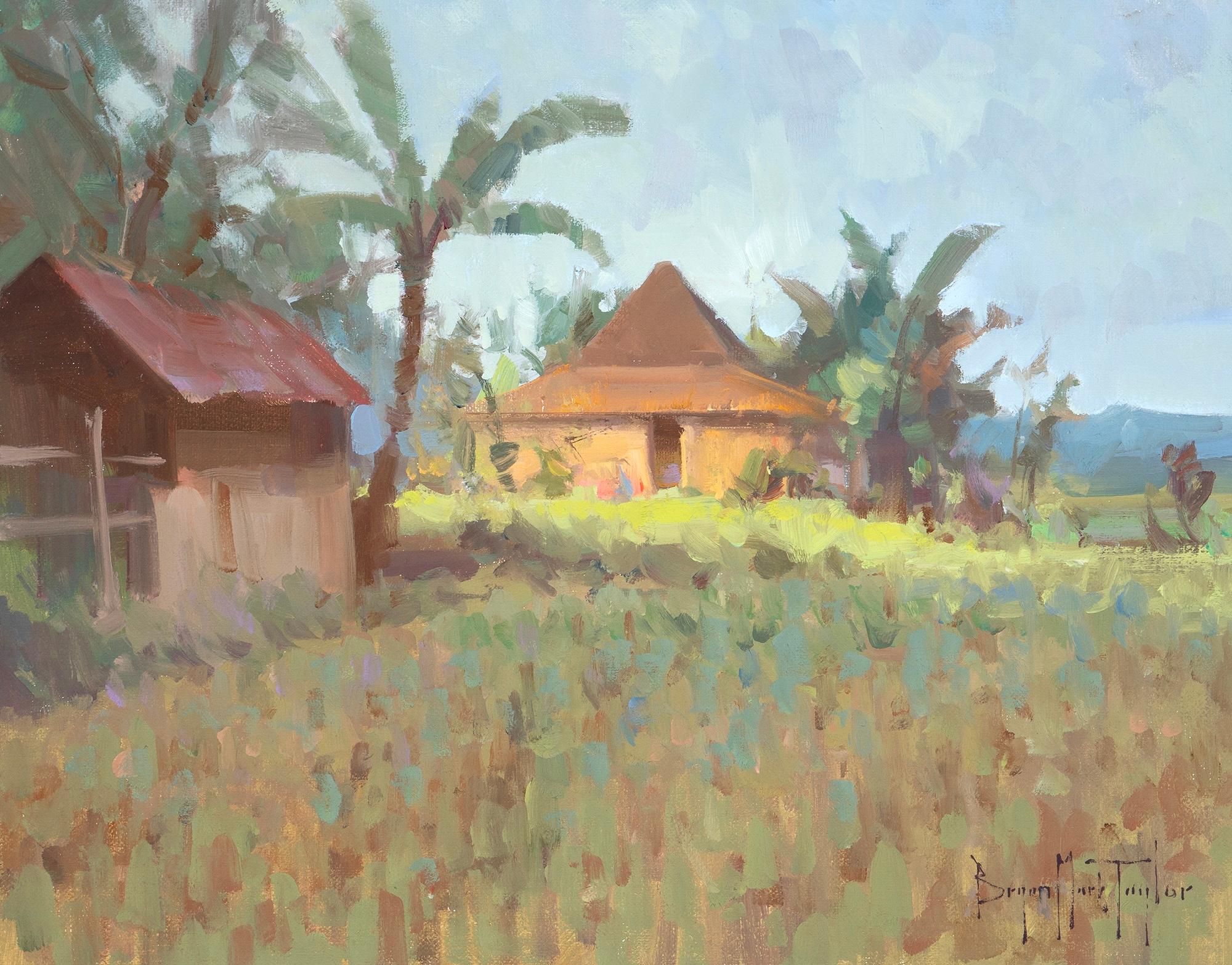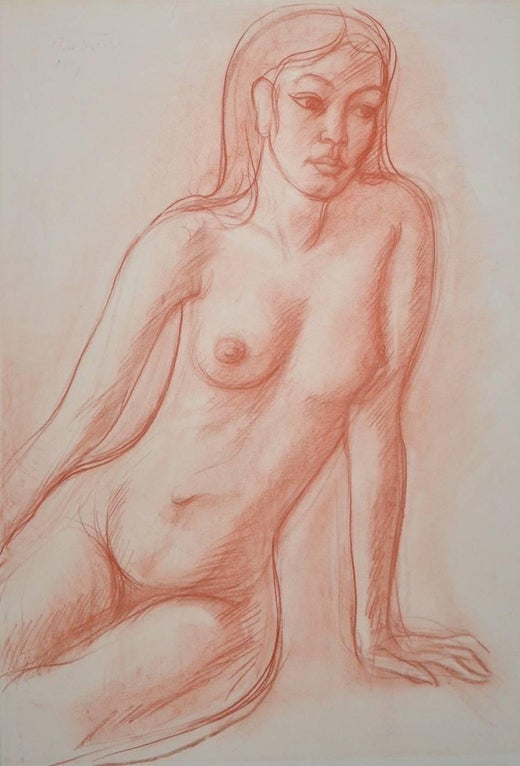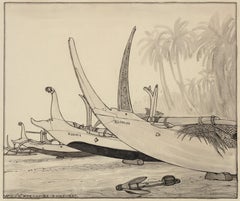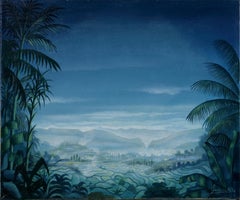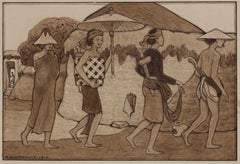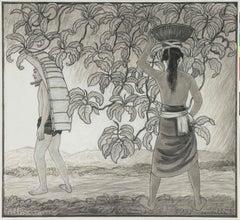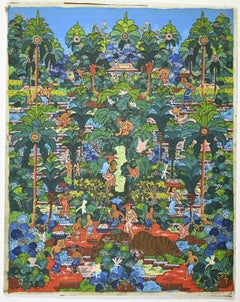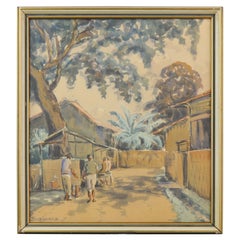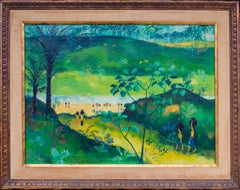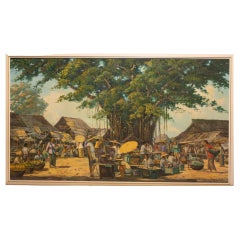Items Similar to Village of Iseh, Bali (1948)
Want more images or videos?
Request additional images or videos from the seller
1 of 6
Theo MeierVillage of Iseh, Bali (1948)1948
1948
$41,497.35
£30,900.25
€35,000
CA$57,019.63
A$63,815.70
CHF 33,306.89
MX$778,222.54
NOK 426,282.85
SEK 403,531.30
DKK 266,424.37
Shipping
Retrieving quote...The 1stDibs Promise:
Authenticity Guarantee,
Money-Back Guarantee,
24-Hour Cancellation
About the Item
Theo Meier (1908-1982)
View of the Village of Iseh, painted from the house of Theo
Signed and dated 48 Theo Meier lower left
Oil on canvas, 68.5 x 50 cm
In original frame carved by the artist.
Note:
Theo Meier arrived in Bali in 1936 with the intention of going on to Tahiti where he had been before. However Bali turned out to be the paradise he had been searching for in his dreams and he had no desire any more to move elsewhere. Bali at that time was still a very traditional place where society lived according to an acient religious system and in a luscious tropical setting the modern world was ignored. Here he met Walter Spies, a German artist who had been living in Bali since 1927 and who guided Theo to a deeper understanding of Balinese culture. Walter had a small mountain retreat in the village of Iseh where he invited Theo who was fascinated by the rustic village with its magnificent view of Mount Agung. In 1938 he married a young girl from the village, Ni Madé Mulugan, and in June 1939 his first daughter was born.
In 1941 he divorced Ni Madé and in1942 he married his favourite model Madé Pegi. In 1942 the war came to Bali when it was occupied by the Japanese army. Theo’s house on Sanur beach was requestioned by the Japanese and since paintings of the female nude were prohibited almost six years of his work was confiscated and destroyed. The Dutch artist in Bali were arrested and interned in Japanese camps, but Theo being a citizen of neutral Switzerland was free to stay anywhere on the island. To avoid the coastal areas which were completely occupied by Japanese troops, Theo moved to the isolated village of Iseh. In 1945 after the bombing of Hiroshima and Nagasaki the Japanese army capitulated but at the request of the ALLIED forces the Japanese stayed in Bali till the arrival of Dutch forces in march 1946.
Now the Indonesian war of independence thrust the archipelago once more into turbulence and Theo decided to stay put in Iseh, where at least not much was happening. He painted the present view of the village in 1948. In 1947 he had already painted the same view and that painting now is in the collection of the Museum UPH in Karawaci (Theo Meier, A Swiss artist under the tropics, ill. page 91).
Before the war Walter Spies also had painted a beautiful picture of the village “Iseh in morning light”. In 1948 Theo’s second daughter was born. In 1950 for the first time in 15 years Theo went back to Basel to find some money to support his family in Bali. When he returned in 1952 he found Madé Pegi in love with a Balinese dancer and they divorced. In 1957 Sukarno decreed that all foreign residents had to leave Indonesia. On the invitation of his friend Price Sanidh Rangsit Theo moved to Thailand. In 1966 he returned to Bali for the first time and he purchased land in Iseh to build a house.
- Creator:Theo Meier (1908 - 1982, Swiss)
- Creation Year:1948
- Dimensions:Height: 26.97 in (68.5 cm)Width: 19.69 in (50 cm)Depth: 1.58 in (4 cm)
- Medium:
- Movement & Style:
- Period:
- Condition:
- Gallery Location:Amsterdam, NL
- Reference Number:1stDibs: LU147128030612
Theo Meier
Theo Meier was a Swiss painter. He was born in Basel in 1908, and first attended the local art school. His breakthrough as an artist came with the commissioned portrait of Jakob Schaffner. Schaffner had suggested he make the acquaintance with various artists such as Max Liebermann, Karl Hofer, Otto Dix and Emil Nolde. The encounter with Gauguin and his primitive, exotic painting impressed him greatly. Several trips brought him to the South Pacific, Thailand, Guadeloupe, Martinique or Tahiti, and Bali, among others. Inspired by the culture, the women, and the landscape of Bali, he decided to emigrate there. Therefore, his works are characterized by these exotic subjects. (Askart)
About the Seller
No Reviews Yet
Vetted Professional Seller
Every seller passes strict standards for authenticity and reliability
1stDibs seller since 2021
- ShippingRetrieving quote...Shipping from: Amsterdam, Netherlands
- Return Policy
Authenticity Guarantee
In the unlikely event there’s an issue with an item’s authenticity, contact us within 1 year for a full refund. DetailsMoney-Back Guarantee
If your item is not as described, is damaged in transit, or does not arrive, contact us within 7 days for a full refund. Details24-Hour Cancellation
You have a 24-hour grace period in which to reconsider your purchase, with no questions asked.Vetted Professional Sellers
Our world-class sellers must adhere to strict standards for service and quality, maintaining the integrity of our listings.Price-Match Guarantee
If you find that a seller listed the same item for a lower price elsewhere, we’ll match it.Trusted Global Delivery
Our best-in-class carrier network provides specialized shipping options worldwide, including custom delivery.More From This Seller
View AllBeach of Kusambe, Bali 1937
Located in Amsterdam, NL
Four outrigger proa’s on the beach of Kusambe, Bali, 1937
Signed with initials, dated and described with location bottom left
Pencil and ink on paper, 29.7 x 35 cm
In ebonized frame with white mount
WILLEM OTTO WIJNAND NIEUWENKAMP
(1874-1950)
Nieuwenkamp was born on July 27th 1874 in Amsterdam. His father owned sailing ships sailing to Indonesia and hearing the stories of the returning captains evoked in the young Nieuwenkamp an obsession for distant lands and adventure. After a failed attempt by his father to have his son make a career in his business, Nieuwenkamp attended the Academy for Decorative Art in Amsterdam. However, he left within one year to go his own way.
He was an autodidact and a great experimenter with new techniques, particularly in the art of etching. Nieuwenkamp was a very focused man with the discipline of a scientist tempered by the sensitivity of an artist, a lust for adventure, a natural appreciation for ethnic arts and an enormous ambition to tread new paths.
In 1898 he visited Indonesia for the first time and on his second visit in 1903-1904 he went on to Bali and became the first foreign artist to love Bali and the Balinese with a passion. Having secured agreements with several museums in the Netherlands to obtain Balinese art and objects for their collections, Nieuwenkamp immediately started to purchase and order a wide range of ethnographic art and objects from local artists and craftsmen.
Through his drawings and books, he gave an excellent impression of Balinese art and culture at that time. Since 1854 Northern Bali was under Dutch...
Category
1930s Art Nouveau Landscape Drawings and Watercolors
Materials
Paper, India Ink, Pencil
Sawah Landscape
Located in Amsterdam, NL
A sawah landscape, Sumatra
Signed and dated 'Sonnega '54' (lower right), and annotated 'Voor Jan de Bas 1-1-1970 / R de Bas' (on the reverse)
oil on canvas, 50,5x60,5 cm
Provenance:
- Collection Pieter de Bas (1909-1979) Mr de Bas was head of the MULO school and acting head of the HBS school in Medan. Thence by descent to the present owner.
Exhibited:
- Hotel de Boer, Medan 1954, where acquired by the first owner.
The light I observed everywhere was of a special quality, fluorescent blue, shone from nowhere but radiated from every point, oddly with great depth and intensity. The light in an entirely different dimension came from nowhere and went nowhere shimmering with the glow of a bright blue jewel. The most important thing I discovered was of being omnipresent and able to understand everything at the same time, yes I could fathom creation completely.
Auke Sonnega, born March 9, 1910 in Leeuwarden, known as the painter, primarily of young Balinese men and women.
Originally raised in the reformed denomination, the parents of Auke apparently practised theosophy and their children, including Auke were taught these principles. The talent for drawing revealed itself at an early stage which in 1926 lead to a 4-year study of textile design at the Academy for Art and Craft in Amsterdam.
He completed the academy in 1930 and worked in a carpet factory in Twente until 1934 and then followed in his sister Aafje’s footsteps leaving the Netherlands to go to the Dutch East Indies where in 1935 he started working as a graphic designer with an advertising bureau in Batavia. He was able to travel through Java and Bali on the motorbike that he brought with him from Europe, and was paid for his travelogue, enhanced with his own photo’s which appeared in several Dutch newspapers and magazines.
In the 1930’s two Europeans, Walter Spies and Rudolf Bonnet...
Category
Mid-20th Century Expressionist Landscape Paintings
Materials
Canvas, Oil
Four Balinese, Bali (1910)
Located in Amsterdam, NL
Four Balinese, 1910
Signed and dated bottom left
Pencil and ink on paper, 15.6 x 23 cm
In ebonized frame with white mount.
Literature:
W.O.J. Nieuwenkamp, Zwerftochten op Bali, Amsterdam, 1910, p. 36
WILLEM OTTO WIJNAND NIEUWENKAMP
(1874-1950)
Nieuwenkamp was born on July 27th 1874 in Amsterdam. His father owned sailing ships sailing to Indonesia and hearing the stories of the returning captains evoked in the young Nieuwenkamp an obsession for distant lands and adventure. After a failed attempt by his father to have his son make a career in his business, Nieuwenkamp attended the Academy for Decorative Art in Amsterdam. However, he left within one year to go his own way.
He was an autodidact and a great experimenter with new techniques, particularly in the art of etching. Nieuwenkamp was a very focused man with the discipline of a scientist tempered by the sensitivity of an artist, a lust for adventure, a natural appreciation for ethnic arts and an enormous ambition to tread new paths.
In 1898 he visited Indonesia for the first time and on his second visit in 1903-1904 he went on to Bali and became the first foreign artist to love Bali and the Balinese with a passion. Having secured agreements with several museums in the Netherlands to obtain Balinese art...
Category
1910s Art Nouveau Landscape Drawings and Watercolors
Materials
Paper, Pencil
Incoming Rain, Bali, 1937
Located in Amsterdam, NL
Incoming rain, Den Pasar, Bali 1937
Signed with initials, dated and titled, bottom right
Black chalk and ink on paper, 42 by 46 cm
Literature:
Ernst Braches en J.F. Heijbroek, W.O...
Category
1930s Art Nouveau Landscape Drawings and Watercolors
Materials
Paper, Graphite
A pair of Indonesian Landscapes, by Charles Legrain (19th century)
Located in Amsterdam, NL
Charles Legrain, (19th century)
Two Javanese landscapes
Both signed Legrain Ch. and one dated 1857
Both oil on canvas, size: 95 x 114 cm
In rich gilt-gesso frame.
(2x).
Category
Mid-19th Century Romantic Landscape Paintings
Materials
Canvas, Oil
Wobbly bridge, Tabanan, Bali, 1937
Located in Amsterdam, NL
Wobbly bridge, Tabanan, Bali, 1937
Signed with initials bottom right and dated, bottom left
Pencil and ink on paper, 22 x 26.3 cm
In ebonized frame with white mount
Willem Otto Wi...
Category
1930s Art Nouveau Landscape Drawings and Watercolors
Materials
Paper, India Ink, Pencil
You May Also Like
Balinese Landscape - Tempera by I Ketut Soki - 1960s
By I Ketut Soki
Located in Roma, IT
Balinese Landscape by Ketut Soki – Tempera on Paper, Signed, 20th Century
This vibrant tempera painting by renowned Balinese artist Ketut Soki captures the lush tropical scenery and...
Category
1960s Contemporary Figurative Paintings
Materials
Tempera, Paper
Large Indonesian Painting on Baord 'Rice Fields of Sumatra' Mountain, 1960's
Located in Amsterdam, Noord Holland
Interesting and finely painted Indonesian painting.
Additional information:
Type: Paintings, Scrolls & Prints
Region of Origin: China
Country of Manufacturing: Indonesia
Period: 20t...
Category
20th Century Chinese Paintings
Materials
Paper
$398 Sale Price
20% Off
Antique Southeast Asian Landscape Painting, by Mystery 20th Century Artist
Located in New York, NY
Mystery Artist
Untitled, c. 20th Century
Oil on canvas
22 x 30 in.
Framed: 28 3/8 x 36 x 1 in.
Signed lower right
Provenance:
Former Humala Pontas collection
Category
20th Century Tribal Landscape Paintings
Materials
Canvas, Oil
GA Kadir, Indonesian Village view, Oil on Canvas.Signed.First half 20 th C
Located in Leuven , BE
Original oil painting by the Indonesian impressionist painter G.A. Kadir: educated as a painter by the Danish van Russel (1898 - 1975) and active in the first half of the 20th centur...
Category
Early 20th Century Indonesian Paintings and Screens
Materials
Canvas, Paint
Bali Jungle Village Procession, Indonesian Figural
Located in Soquel, CA
Lively and detailed depiction of a procession of Balinese figures in the Ubud regional style (Cremation Ceremony) by I Dewa Putu Sugi (Indonesian, b. 1931). ...
Category
Mid-20th Century Folk Art Figurative Paintings
Materials
Canvas, Acrylic
$1,625 Sale Price
24% Off
"Bali Rice Fields" Modern Impressionist Scene in Bali
By Bryan Mark Taylor
Located in Laguna Beach, CA
"Bali Rice Fields" is a colorful example of Bryan Mark Taylor's modern approach to Impressionism. This beautiful oil on panel captures the mood and feel of the Balinese scene. Pain...
Category
2010s Abstract Impressionist Landscape Paintings
Materials
Oil
More Ways To Browse
Mid Century Tropical Art
Germany Rosewood
Bali Dancer
Original Vintage Tropical Paintings
Vintage Dutch Girl
Made In Occupied Japan
Balinese Painting Bali
Vintage Balinese Painting
Rosewood Thailand
Siamese Rosewood
Leigh Block
Nancy Wilds
R Marsh
Redwood Forest
Saint Malo
Thomas Hughes
Trevor Brown
Used Western Spurs
